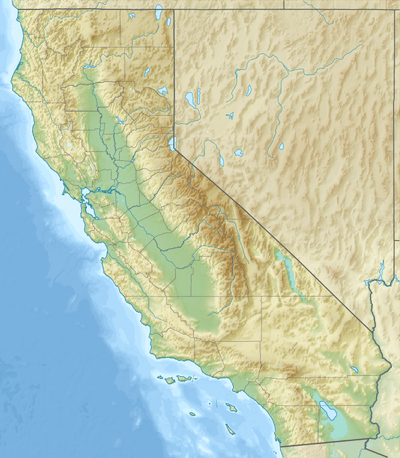San Diego River
The San Diego River is a river in San Diego County, California. It originates in the Cuyamaca Mountains northwest of the town of Julian, then flows to the southwest until it reaches the El Capitan Reservoir, the largest reservoir in the river's watershed at 112,800 acre feet (139,100,000 m3). Below El Capitan Dam, the river runs west through Santee and San Diego. While passing through Tierrasanta it goes through Mission Trails Regional Park, one of the largest urban parks in America. The river discharges into the Pacific Ocean near the entrance to Mission Bay, forming an estuary.
| San Diego River | |
|---|---|
 Looking upstream near mouth | |
 Location of the mouth of the San Diego River in California | |
| Location | |
| Country | United States |
| State | California |
| Region | San Diego County |
| Physical characteristics | |
| Source | Cuyamaca Mountains |
| • location | 5 miles (8 km) northwest of Julian, California |
| • coordinates | 33°07′09″N 116°39′00″W[1] |
| • elevation | 3,750 ft (1,140 m) |
| Mouth | Mission Bay |
• location | Community of Ocean Beach, San Diego, California |
• coordinates | 32°45′37″N 117°12′45″W[1] |
• elevation | 13 ft (4.0 m)[1] |
| Length | 52 mi (84 km) |
| Basin size | 420 sq mi (1,100 km2)[2] |
| Discharge | |
| • average | 38.3 cu ft/s (1.08 m3/s) |
| • minimum | 0 cu ft/s (0 m3/s) |
| • maximum | 94,500 cu ft/s (2,680 m3/s) |
History
The river has changed its course several times in recorded history. When the first European settlers arrived in the late 18th century it emptied into False Bay, the present day Mission Bay. At some point in the 1820s it altered course and began to empty into San Diego Bay, which continued for nearly 50 years. Because of fears that the harbor would silt up, the river was diverted to its present course in 1877 by a dam and the straightening of the channel to the ocean.[3]
Water rights
In 1921, the city of San Diego filed suit against the Cuyamaca Water Company to establish its paramount right to the water of the San Diego River. After several court cases, the California State Supreme Court declared in 1929 that the city's right was paramount because under Spanish and Mexican laws, the pueblo of San Diego was given exclusive rights to the use of the San Diego River, both surface and underground. The Treaty of Guadalupe-Hidalgo obligated the U.S. to protect the grants and privileges decreed under the old rule.[4]
Course
The river travels 52 miles (84 km) from its headwaters to the ocean. The river's tributaries include:
- Oak Canyon Creek
- Spring Canyon Creek
- Forester Creek
- Los Coches Creek
- San Vicente Creek
- Wildcat Canyon Creek
- Chocolate Creek
- Conejos Creek
- Sand Creek
- Isham Creek
- Boulder Creek
- Cedar Creek
- Ritchie Creek
- Dye Canyon Creek
- Iron Springs Canyon Creek
- Temescal Creek
- Sentenac Creek
- Coleman Creek
- Baily Creek
- Jim Green Creek
- Boring Creek
- Marriette Creek
- Jim Green Creek
- Eastwood Creek
- Baily Creek
Four additional reservoirs lie in the river's watershed. Cuyamaca Reservoir is located on Boulder Creek and San Vicente Reservoir is fed by San Vicente Creek. Lake Jennings and Lake Murray are formed by the damming of canyons.
The San Diego River Park Foundation was founded in 2001 and is dedicated to conserving the water, wildlife, recreation, culture and community involved with the San Diego River.[5]
The San Diego River Conservancy was established by an act of the California Legislature to preserve, restore and enhance the San Diego River area. The Conservancy is a non-regulatory agency of the state government with an independent nine-member governing board. It is tasked to acquire, manage and conserve land and to protect or provide recreational opportunities, open space, wildlife species and habitat, wetlands, water quality, natural flood conveyance, historical/cultural resources, and educational opportunities. One important goal is to help create a river-long park and hiking trail, stretching the full length of the river from its headwaters in the Cuyamaca Mountains to the Pacific Ocean.[6]
 Mouth
Mouth Channel south of Mission Bay
Channel south of Mission Bay Crossing in Mission Trail Regional Park
Crossing in Mission Trail Regional Park Old Mission Dam in Mission Trails Regional Park
Old Mission Dam in Mission Trails Regional Park Coast to Crest Trail crosses river near headwaters
Coast to Crest Trail crosses river near headwaters
Crossings
From mouth to source:
San Diego
|
Santee
Lakeside
Julian
|
References
- U.S. Geological Survey Geographic Names Information System: San Diego River
- "Boundary Descriptions and Names of Regions, Subregions, Accounting Units and Cataloging Units". U.S. Geological Survey. Retrieved 2010-08-22.
- Smythe, William, History of San Diego, 1542-1908, Part 7, Chapter 2
- "A History of the Dams and Water Supply of Western San Diego County," by Lloyd Charles Fowler, 1953
- San Diego River Park Foundation website
- San Diego River Conservancy website